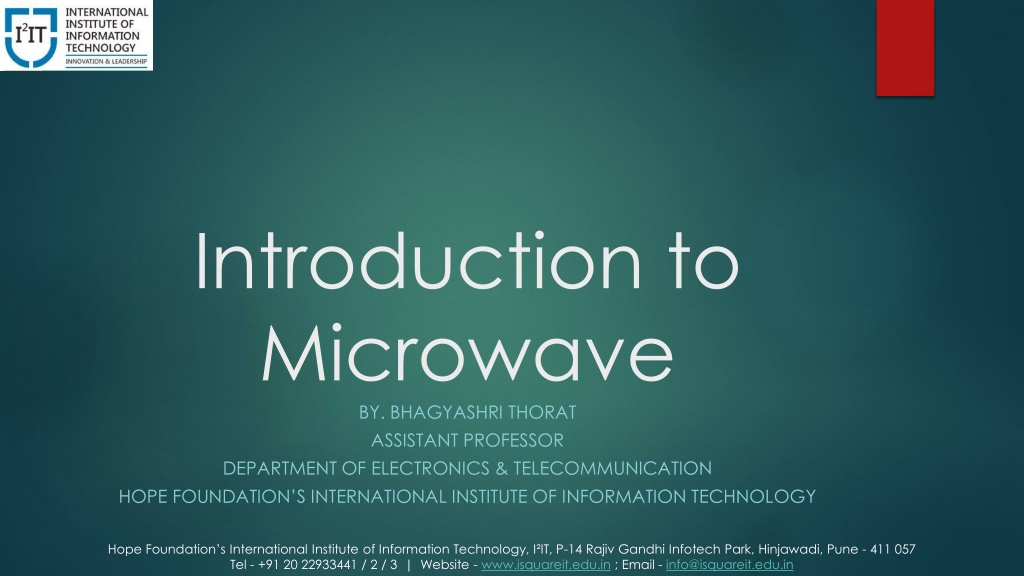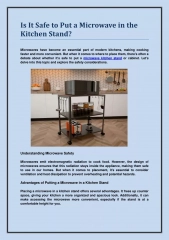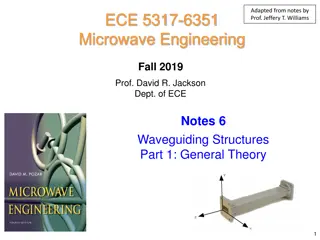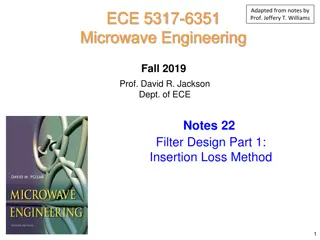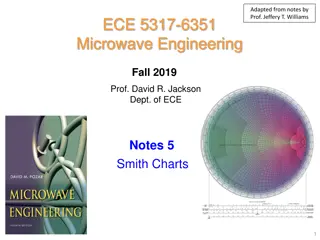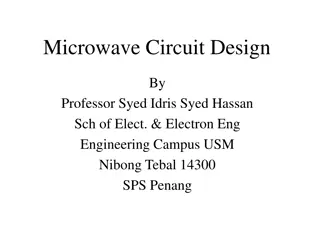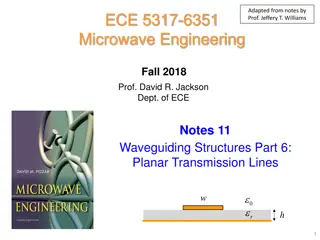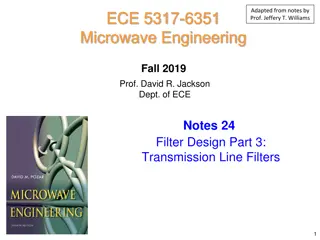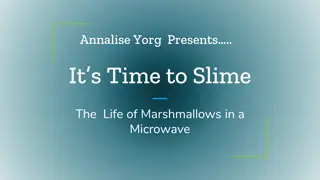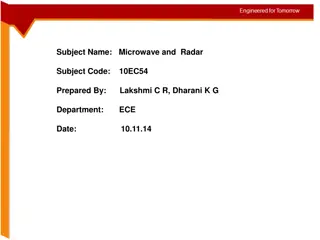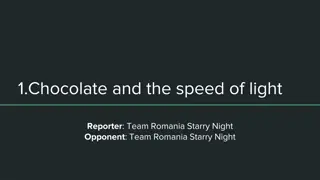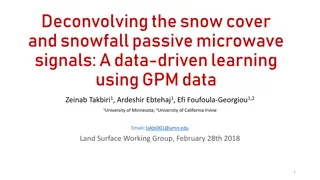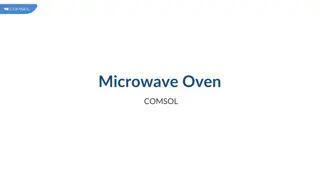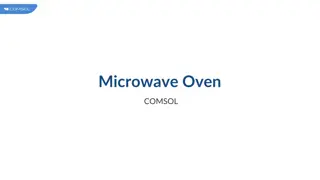Introduction to Microwave Technology
Microwave technology is an integral part of modern communication systems and is based on the electromagnetic spectrum. This technology has a rich history starting from Maxwell's equations in the 19th century to modern applications in telecommunication and radar systems. Understanding the electromagnetic spectrum and its significance in microwave technology is crucial for electronics and telecommunication enthusiasts. Explore the brief history of microwaves from Maxwell's predictions to Hertz's experimental confirmation and Marconi's contributions to antenna technology. Join us in uncovering the fascinating world of microwave technology at Hope Foundation's International Institute of Information Technology.
Download Presentation

Please find below an Image/Link to download the presentation.
The content on the website is provided AS IS for your information and personal use only. It may not be sold, licensed, or shared on other websites without obtaining consent from the author.If you encounter any issues during the download, it is possible that the publisher has removed the file from their server.
You are allowed to download the files provided on this website for personal or commercial use, subject to the condition that they are used lawfully. All files are the property of their respective owners.
The content on the website is provided AS IS for your information and personal use only. It may not be sold, licensed, or shared on other websites without obtaining consent from the author.
E N D
Presentation Transcript
Introduction to Microwave BY. BHAGYASHRI THORAT ASSISTANT PROFESSOR DEPARTMENT OF ELECTRONICS & TELECOMMUNICATION HOPE FOUNDATION S INTERNATIONAL INSTITUTE OF INFORMATION TECHNOLOGY Hope Foundation s International Institute of Information Technology, I IT, P-14 Rajiv Gandhi Infotech Park, Hinjawadi, Pune - 411 057 Tel - +91 20 22933441 / 2 / 3 | Website - www.isquareit.edu.in ; Email - info@isquareit.edu.in
Electromagnetic Spectrum & spectrum meaning a band of colours, as seen in a rainbow, produced by separation of the components of light by their different degrees of refraction according to wavelength. the entire range of wavelengths of electromagnetic radiation. noun: the spectrum a characteristic series of frequencies of electromagnetic radiation emitted or absorbed by a substance. the components of a sound or other phenomenon arranged according to such characteristics as frequency, charge, and energy. used to classify something in terms of its position on a scale between two extreme points. Hope Foundation s International Institute of Information Technology, I IT, P-14 Rajiv Gandhi Infotech Park, Hinjawadi, Pune - 411 057 Tel - +91 20 22933441 / 2 / 3 | Website - www.isquareit.edu.in ; Email - info@isquareit.edu.in
Electromagnetic Spectrum Hope Foundation s International Institute of Information Technology, I IT, P-14 Rajiv Gandhi Infotech Park, Hinjawadi, Pune - 411 057 Tel - +91 20 22933441 / 2 / 3 | Website - www.isquareit.edu.in ; Email - info@isquareit.edu.in
Hope Foundations International Institute of Information Technology, IIT, P-14 Rajiv Gandhi Infotech Park, Hinjawadi, Pune - 411 057 Tel - +91 20 22933441 / 2 / 3 | Website - www.isquareit.edu.in ; Email - info@isquareit.edu.in
Brief Microwave History Maxwell (1864-73) integrated electricity and magnetism set of 4 coherent and self-consistent equations predicted electromagnetic wave propagation Hertz (1886-88) experimentally confirmed Maxwell s equations oscillating electric spark to induce similar oscillations in a distant wire loop ( =10 cm) Hope Foundation s International Institute of Information Technology, I IT, P-14 Rajiv Gandhi Infotech Park, Hinjawadi, Pune - 411 057 Tel - +91 20 22933441 / 2 / 3 | Website - www.isquareit.edu.in ; Email - info@isquareit.edu.in
Brief Microwave History Marconi (early 20th century) parabolic antenna to demonstrate wireless telegraphic communications tried to commercialize radio at low frequency Lord Rayleigh (1897) showed mathematically that EM wave propagation possible in waveguides George Southworth (1930) showed waveguides capable of small bandwidth transmission for high powers Hope Foundation s International Institute of Information Technology, I IT, P-14 Rajiv Gandhi Infotech Park, Hinjawadi, Pune - 411 057 Tel - +91 20 22933441 / 2 / 3 | Website - www.isquareit.edu.in ; Email - info@isquareit.edu.in
Brief Microwave History R.H. and S.F. Varian (1937) development of the klystron MIT Radiation Laboratory (WWII) radiation lab series - classic writings Development of transistor (1950 s) Development of Microwave Integrated Circuits microwave circuit on a chip microstrip lines Satellites, wireless communications, ... Hope Foundation s International Institute of Information Technology, I IT, P-14 Rajiv Gandhi Infotech Park, Hinjawadi, Pune - 411 057 Tel - +91 20 22933441 / 2 / 3 | Website - www.isquareit.edu.in ; Email - info@isquareit.edu.in
Advantages of Microwaves Increased bandwidth availability More bandwidth can be realized at higher frequencies. Bandwidth is critically important because available frequency bands in the electromagnetic spectrum are being rapidly depleted. Microwave signals travel by line of sight are not bent by the ionosphere as are lower frequency signals and thus satellite and terrestrial communication links with very high capacities are possible. Effective reflection area (radar cross section) of a radar target is proportional to the target s electrical size. Thus generally microwave frequencies are preferred for radar systems. Hope Foundation s International Institute of Information Technology, I IT, P-14 Rajiv Gandhi Infotech Park, Hinjawadi, Pune - 411 057 Tel - +91 20 22933441 / 2 / 3 | Website - www.isquareit.edu.in ; Email - info@isquareit.edu.in
Advantages of microwaves Hope Foundation s International Institute of Information Technology, I IT, P-14 Rajiv Gandhi Infotech Park, Hinjawadi, Pune - 411 057 Tel - +91 20 22933441 / 2 / 3 | Website - www.isquareit.edu.in ; Email - info@isquareit.edu.in
Advantages of microwaves Power Requirments: Transmitters/Receivers power requirments are pretty low at microwave frequencies compared to short wave band Transparency property of microwaves: Microwave frequency band ranging from 300 MHz -10 GHz are capable of freely propagating through the ionized layers surrounding the earth as well as through the atmosphere. Hope Foundation s International Institute of Information Technology, I IT, P-14 Rajiv Gandhi Infotech Park, Hinjawadi, Pune - 411 057 Tel - +91 20 22933441 / 2 / 3 | Website - www.isquareit.edu.in ; Email - info@isquareit.edu.in
Application of microwave Various molecular, atomic, and nuclear resonances occur at microwave frequencies, creating a variety of unique applications in the areas of basic science, remote sensing, medical diagnostics and treatment, and heating methods. Today, the majority of applications of microwaves are related to radar and communication systems. Radar systems are used for detecting and locating targets and for air traffic control systems, missile tracking radars, automobile collision avoidance systems, weather prediction, motion detectors, and a wide variety of remote sensing systems. Microwave communication systems handle a large fraction of the world s international and other long haul telephone, data and television transmissions. Most of the currently developing wireless telecommunications systems, such as direct broadcast satellite (DBS) television, personal communication systems (PCSs), wireless local area networks (WLANS), cellular video (CV) systems, and global positioning satellite (GPS) systems rely heavily on microwave technology. Hope Foundation s International Institute of Information Technology, I IT, P-14 Rajiv Gandhi Infotech Park, Hinjawadi, Pune - 411 057 Tel - +91 20 22933441 / 2 / 3 | Website - www.isquareit.edu.in ; Email - info@isquareit.edu.in
Thank You For further details please feel free to contact Bhagyashri Thorat Department of Electronics & Telecommunication Hope Foundation s International Institute of Information Technology, I IT P-14, Rajiv Gandhi Infotech Park, MIDC Phase 1, Hinjawadi, Pune 411 057 Tel +91 20 22933441 / 2 /3 www.isquareit.edu.in bhagyashrit@isquareit.edu.in | info@isquareit.edu.in
